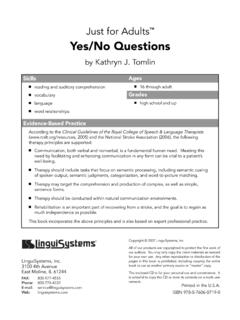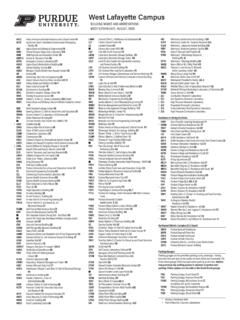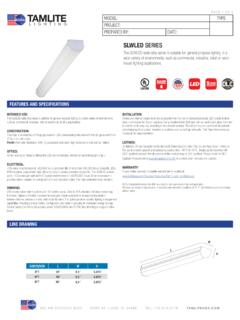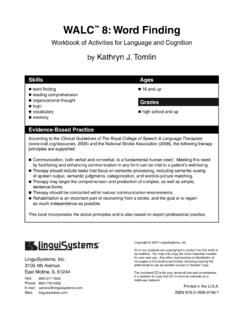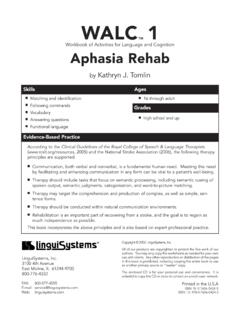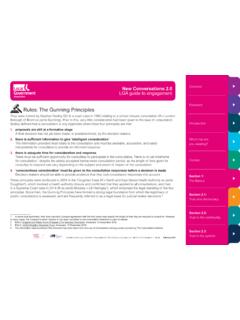Transcription of Just for Adults Deductions
1 GradesCopyright 2007 LinguiSystems, of our products are copyrighted to protect the fine work ofour authors. You may only copy the client materials as neededfor your own use. Any other reproduction or distribution of thepages in this book is prohibited, including copying the entirebook to use as another primary source or master in the 978-0-7606-0716-9 LinguiSystems, 4th AvenueEast Moline, IL 61244800-776-4332 FAX:800-577-4555E-mail: for AdultsDeductionsbyKathryn J. TomlinSkillsAges deductive reasoning 16 through adult reading and auditory comprehension inclusion and exclusion inferences high school and up vocabulary critical thinkingEvidence-Based PracticeAccording to the Clinical Guidelines of the Royal College of Speech & Language Therapists( , 2005) and the National Stroke Association (2006), the following therapy principles are supported.
2 Communication, both verbal and nonverbal, is a fundamental human need. Meeting this need by facilitating and enhancing communication in any form can be vital to a patient s well-being. Therapy should include tasks that focus on semantic processing, including semantic cueingof spoken output, semantic judgments, categorization, and word-to-picture matching. Therapy may target the comprehension and production of complex, as well as simple,sentence forms. Therapy should be conducted within natural communication environments. Rehabilitation is an important part of recovering from a stroke, and the goal is to regain asmuch independence as book incorporates the above principles and is also based on expert professional practice.
3 About the AuthorKathryn J. Tomlin, , CCC-SLP, has been a speech-languageclinician in hospitals, rehabilitation centers, and in long-term carefacilities for over 25 years. She has authored many materials withLinguiSystems over the last 20 years. Some of her works include:WALC 1(Workbook of Activities for Language and Cognition) Aphasia RehabWALC 2 Cognitive RehabWALC 8 Word FindingWALC 9 Verbal and Visual ReasoningWALC 10 MemoryWALC 11 Language for Home ActivitiesThe Source for Apraxia TherapyKathy and her therapy dog, ZanmiZanmi, Kathy s Samoyed, goes to work with her to encourage the clients enjoy feeding and spending time with Zanmi, and Zanmienjoys their company.
4 Everybody wins!DedicationThis book is respectfully dedicated to Danielle Fedele. Thanks for all your help in usingthe exercises in this series of books. I couldn t have done it without you. May yourjourney in the world of speech-language pathology be fulf illing and by Lauri WhiskeymanPage Design by Christine BuysseCover Design by Jeff TaylorIllustrations by Margaret WarnerJust for Adults : Deductions3 Copyright 2007 LinguiSystems, of ContentsIntroduction .. 4 Screening.. 6 Word Deductions Sentence Form .. 7 Word Deductions Three Clues .. 10 Syllogisms If / Then .. 13 What May Result If / Then .. 15 What May Result What /If .. 16 Inferential Situations.
5 17 Who Would .. 19 What Might Cause Someone to .. 20 Which One Is It? .. 21 Figural Classes Given Characteristic .. 24 Object Classes Given Characteristic .. 27 Figural Patterns Inclusion /Exclusion .. 30 Determine the Class .. 33 Critical Thinking .. 36 Answer Key.. 39 just for Adults : Deductions4 Copyright 2007 LinguiSystems, reasoning and making inferences are an integral part of our daily communication. We usecritical thinking in multiple ways every day. We reason whenever information is presented to ability to use this kind of thinking is frequently impaired in someone who has language orthinking diff iculties. Communication, decision making, and problem solving can become veryconfusing or overwhelming if these skills are impaired.
6 Many factors can hinder the ability to usedeductive reasoning, such as: Diff iculty understanding language or concepts due to aphasia. Diff iculty using convergent and divergent language skills. Diff iculty mentally holding and manipulating information so one can come to a logicalconclusion. Impulsivity causing action before receiving and analyzing all pertinent information. Becoming overwhelmed with mentally-held information and new exercises in just for Adults : Deductionswere developed to address verbal/written deductivereasoning and inferencing followed by f igural and object deduction . These skills are the foundation formany language and thought processes and for activities of daily functioning.
7 The exercises in this bookcan be done in multiple ways. Have the clients read items silently and complete them independently. Have the clients read task items aloud and write the response. In general, performanceimproves when a person has multi-modality input ( , hearing it while reading it). Read the items to the client and have the client give responses manipulation and deduction are more complex thinking skills so be sure to give your clientample time to reason and think before responding. It is important to remember that the clients whowill use these exercises are very concrete thinkers and will tend to have divergent reasoning patternsthat link information tangentially.
8 The items have been written to assist in re-establishing convergentthinking, but at times your client may need cues to aid with exercises in this book teach processes needed for successful deductive reasoning, decision making,and determining actions. All tasks are worded in a manner and set up on the pages in specif ic ways toassist clients in developing the processes needed for these critical thinking skills. When doing thetasks, it is more important to monitor the client s manner of processing rather than if the specif ic targetanswer is correctly determined. If the client is considering all of the salient information, usingconvergent reasoning, and is exhibiting all of the necessary thinking components when doing anexercise, then the task is successful, whether or not the exact target answer is determined.
9 When acertain process seems to be missing from a client s line of reasoning, that is what should be cued inorder to assist the client in re-establishing these basic foundational for Adults : Deductions5 Copyright 2007 LinguiSystems, page 6, you will f ind a screening tool that is not to be used as a test but rather as a way to observea client s use of strategies and reasoning patterns. Some questions to think about while observinghow the client completes the screening the client need to use verbal rehearsal to aid comprehension? the client impulsive, and does his impulsivity lead to errors? the client read too much into the task and become confused?
10 The client aware of his error responses? the client ask for clarif ication when having diff iculty or does he just keep going, whether the item is understood or not? the client miss salient information? the client able to think convergently and divergently? the client have trouble shifting from one task to the next?Use the information gleaned during your observations to help the client re-establish effective strategieswhile doing the exercises in this guidelines will help you present the activities in this book. The goals of the exercises are to improve a client s ability to reason, make inferences, and thencome to a conclusion. There are multiple answers for many of the exercise items.


